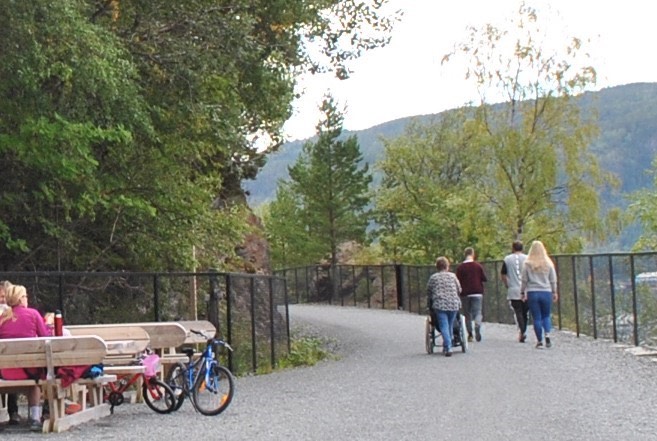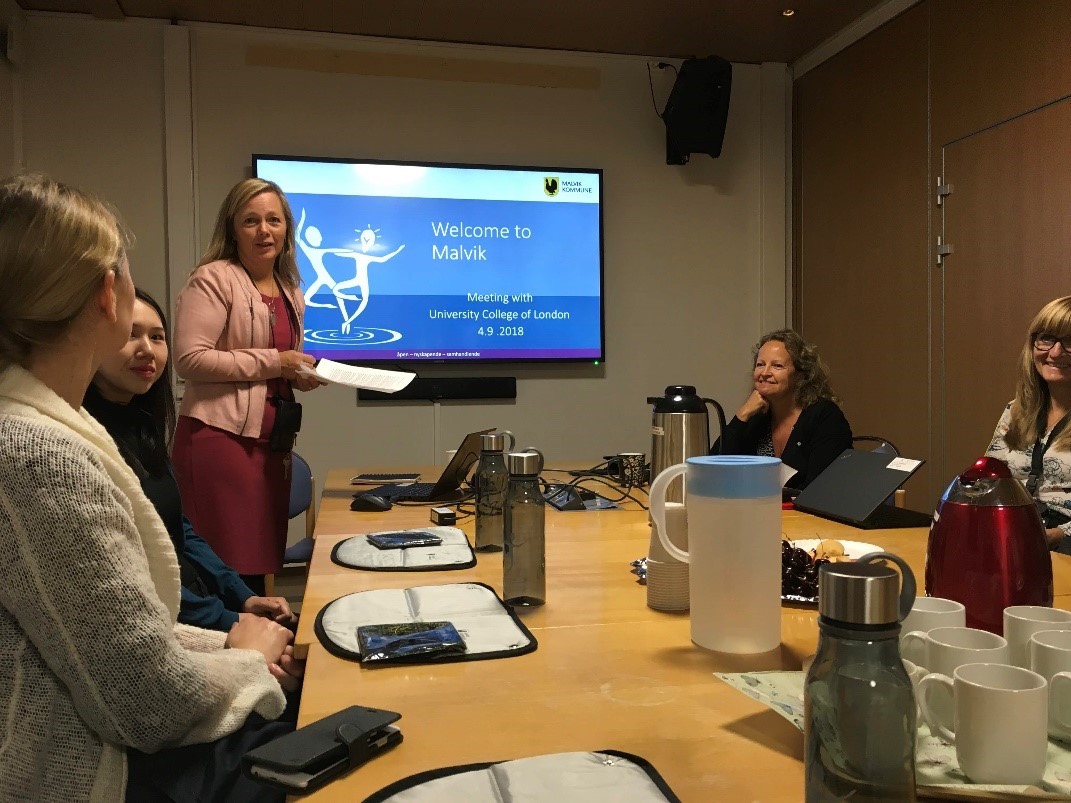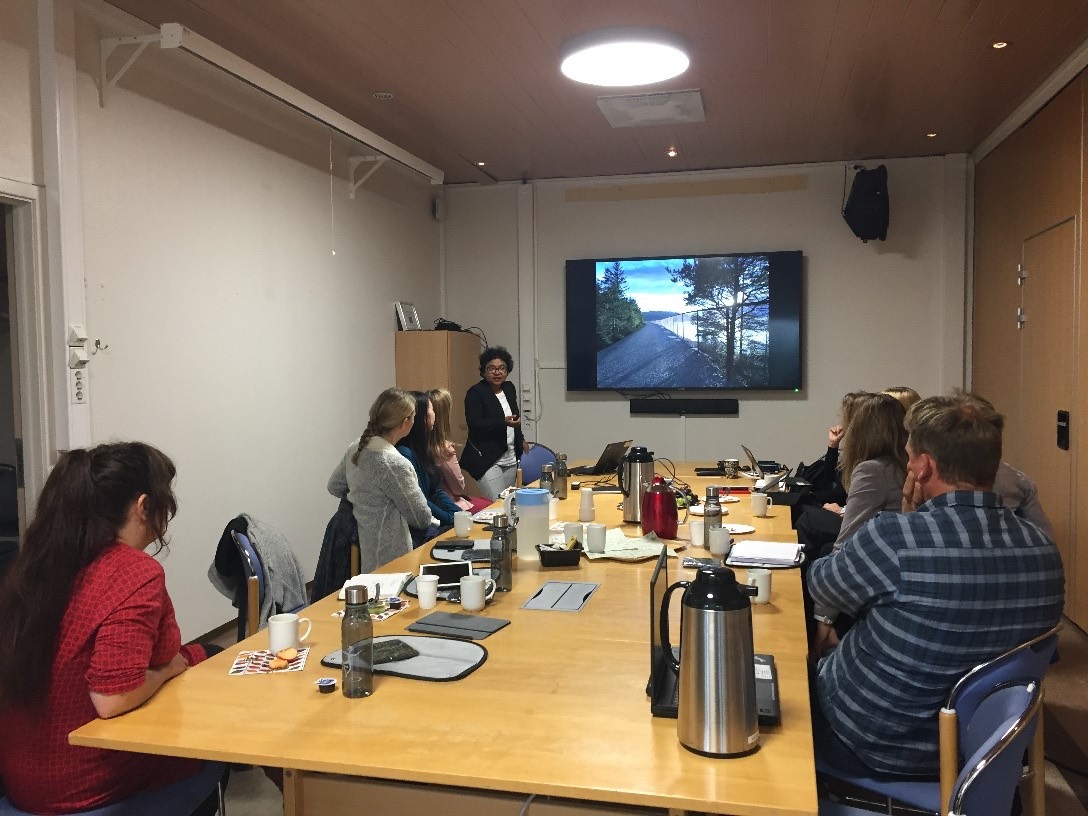
Malvik Path, Norway (Photo: Matluba Khan)
Written by Matluba Khan and Kirsti Sarheim Anthun
Malvik path is a Triple-win case study in Norway, situated just outside the city of Trondheim. It is a 3 kilometre long scenic path along the coast that connects two local residential areas. The path was built on an abandoned railway. When the railway was moved from this area to inland, the local politicians and municipal administrators started exploring ideas on how the area can be developed as an open space accessible to public. The residents of Hommelvik wanted a green area in their locality for social interaction and physical activity along the coast. The idea of the path came during a research conference involving all the stakeholders organised by the Norwegian University of Science and Technology (NTNU) in partnership with the Malvik Municipality. The construction of the path was funded by the Malvik Municipality, the Norwegian Environment Agency and the National Railway Network.
Malvik path was officially opened for public in June 2016. The path is universally accessible; people of different ages use the path on a daily basis for various physical and recreational activities. The surface material was chosen carefully to make the path accessible to wheelchair users; families with kids also find it user-friendly for prams. There is seating at several spots placed along the path, where people can take a rest and picnic, along with places to fish, sunbathe and swim. Young people who like a more adventurous walk can choose the trail to the forest adjacent to the path. Toilet facilities have also been recently built at the beginning and the end of the path based on a user evaluation participated by children and elderly people. The municipality of Malvik is interested in a holistic evaluation of the path, which aligns with the objectives of the INHERIT evaluation to assess the impacts of the Triple-win – health behaviour, environmental sustainability and health equity.
UCL is leading the quantitative evaluation of 8 out of the 16 Triple-win studies (identified for implementation and evaluation by the INHERIT consortium) across Europe and will evaluate the benefits and impact of Malvik path. Malvik Path is one of the four studies in the area of ‘living,’ the other three are Thinking Fadura in Spain, Restructuring Residential Open Space in Sweden and Restructuring Green Spaces in the Netherlands. iSOPARC, an observational tool is being used for obtaining direct information on people’s use of open spaces that can lead to developing suggestions for policymaking and recommendations for design and planning. iSOPARC, an iPAD application was used to record the data digitally. A workshop was organised on behalf of the UCL earlier this year in Spain (hosted in BC3 Research) in order to train representatives from the four studies and reach a consensus around issues that might arise during the data collection process.

People of all ages and families visit the path and use it regularly for walking (Photo: Matluba Khan)

On behalf of the University College of London (UCL), I [Matluba] visited the Malvik path in early September 2018 to understand the context where Malvik path is situated, support NTNU colleagues in collection of data using iSOPARC, and gather some qualitative observational information that can be helpful in the analysis of data and evaluation process. The visit also included a meeting with the Malvik municipality and colleagues from NTNU in order to listen to the stories from the people who worked hard on building the path. During the meeting, the municipality administrators presented on history of this path, design and development process, participation of the community and evaluation of the path, while I presented what the evaluation of INHERIT studies and the site visit on Malvik path entailed.
People of all abilities visit the path regularly (Photo: Matluba Khan)
Along with my colleague, Dr Kirsti Sarheim Anthun (NTNU), we visited the site and collected data on both a weekend and a regular weekday. A counter was installed in the path since its opening and records the number of people visiting the path each day. Along with collecting data using iSOPARC, we conducted small interviews with some users of the park which were chosen at random. Most people who we met on the path were from the nearby areas, however we also met a family who came to visit having heard about the path from their friends. People of different ages use the path daily—we met elderly people, families with young children, persons in wheelchairs, people on bikes and also dog walkers. We came across some of them on both days we visited, indicating their daily use. Most people use the path for walking and running. Easy access, the scenic view, and accessibility for bikes and wheelchairs are important features that draw them to the path.
During the site visit, we happened to meet Ms Ingrid Aune, the Mayor of the Malvik Municipality during her regular walking meeting along the path with the Vice Mayor. We seized this opportunity to learn her insights on the development and the use of the path. The Mayor mentioned that she used the facility regularly for long walking meetings and having the facility in the vicinity was helpful to have some time outside, staying active while working. I thought the use of the path by the Mayor and Vice Mayor themselves gives an important message to the community and the world, about the value the municipality gives to the voices and health needs of the people and the importance of having accessible open spaces for all people for increased physical activity.
Malvik Path is a very good example of a public health intervention, an outcome of inter-sectoral collaboration engaging the community and aiming for the Triple-Win. The INHERIT consortium is playing a key role in terms of a mixed-methods evaluation of the path, and this work will ensure a firmer knowledge base on best practices when it comes to the development of green spaces and policy endeavours for ensuring healthier, sustainable and equitable future for European and global citizens.
Learn more about Malvik Path as a selected INHERIT triple-win case study.





